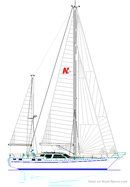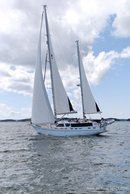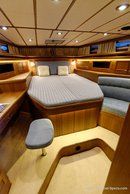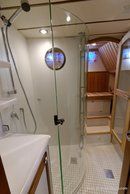Nauticat 525
Sailboat specifications
The Nauticat 525 is a 52’2” (15.9m) motorsailer designed by Siltala Design Office (Finland). She was built between 2010 and 2018 by Nauticat Yachts (Finland).
Nauticat 525's main features
- Model
- Nauticat 525
- Hull type
- Monohull
- Category
- Offshore motorsailer
- Sailboat builder
- Sailboat designer
- Sailboat range
- Country
- Finland
- Construction
- GRP (glass reinforced polyester):
Single skin fiberglass polyester - First built hull
- 2010
- Last built hull
- 2018
- Appendages
- Keel : semi-full keel
- Helm
- Twin helm wheels
- Rudder
- Single semi-spade rudder
- Unsinkable
- No
- Trailerable
- No
- EC design categoryiThe CE design category indicates the ability to cope with certain weather conditions (the sailboat is designed for these conditions)
A: Wind < force 9, Waves < 10m
B: Wind < force 8, Waves < 8m
C: Wind < force 6, Waves < 4m
D: Wind < force 4, Waves < 0,5m - A
- Standard public price ex. VAT (indicative only)
- About880 000 €(2017)
Nauticat 525's main dimensions
- Overall length
- 54’ 7”16.65 m
- Hull length
- 52’ 2”15.9 m
- Waterline length
- 40’12.2 m
- Beam (width)
- 15’ 1”4.6 m
- Draft
- 7’ 2”2.2 m
- Mast height from DWL
- 77’ 1”23.5 m
- Fore freeboard
- 5’ 8”1.75 m
- Mid-ship freeboard
- 5’ 5”1.65 m
- Light displacement (MLC)
- 52911 lb24000 kg
- Ballast weight
- 19180 lb8700 kg
Nauticat 525's rig and sails
- Upwind sail area
- 1525 ft²141.7 m²
- Downwind sail area
- 2918 ft²271.1 m²
- Mainsail area
- 464 ft²43.1 m²
- Mizzen sail area
- 215 ft²20 m²
- Genoa area
- 846 ft²78.6 m²
- Symmetric spinnaker area
- 2239 ft²208 m²
- Gennaker area
- 2110 ft²196 m²
- Rigging type
- Ketch Marconi masthead
- Mast configuration
- Keel stepped mast
- Rotating spars
- No
- Number of levels of spreaders
- 3
- Spreaders angle
- 0 °
- Spars construction
- Aluminum spars
- Standing rigging
- 1x19 strand wire
Nauticat 525's performances
- Upwind sail area to displacementiThe ratio sail area to displacement is obtained by dividing the sail area by the boat's displaced volume to the power two-thirds.
The ratio sail area to displacement can be used to compare the relative sail plan of different sailboats no matter what their size.
Upwind: under 18 the ratio indicates a cruise oriented sailboat with limited performances especially in light wind, while over 25 it indicates a fast sailboat. - 183 ft²/T17.03 m²/T
- Downwind sail area to displacementiThe ratio sail area to displacement is obtained by dividing the sail area by the boat's displaced volume to the power two-thirds.
The ratio sail area to displacement can be used to compare the relative sail plan of different sailboats no matter what their size. - 351 ft²/T32.58 m²/T
- Displacement-length ratio (DLR)iThe Displacement Length Ratio (DLR) is a figure that points out the boat's weight compared to its waterline length. The DLR is obtained by dividing the boat's displacement in tons by the cube of one one-hundredth of the waterline length (in feet).
The DLR can be used to compare the relative mass of different sailboats no matter what their length:
a DLR less than 180 is indicative of a really light sailboat (race boat made for planning), while a DLR greater than 300 is indicative of a heavy cruising sailboat. - 374
- Ballast ratioiThe Ballast ratio is an indicator of stability; it is obtained by dividing the boat's displacement by the mass of the ballast. Since the stability depends also of the hull shapes and the position of the center of gravity, only the boats with similar ballast arrangements and hull shapes should be compared.
The higher the ballast ratio is, the greater is the stability. - 36 %
- Critical hull speediAs a ship moves in the water, it creates standing waves that oppose its movement. This effect increases dramatically the resistance when the boat reaches a speed-length ratio (speed-length ratio is the ratio between the speed in knots and the square root of the waterline length in feet) of about 1.2 (corresponding to a Froude Number of 0.35) . This very sharp rise in resistance, between speed-length ratio of 1.2 to 1.5, is insurmountable for heavy sailboats and so becomes an apparent barrier. This leads to the concept of "hull speed".
The hull speed is obtained by multiplying the square root of the waterline length (in feet) by 1.34. - 8.48 knots
Nauticat 525's auxiliary engine
- Engine(s)
- 1 inboard engine
- Engine(s) power
- 150 HP
- Fuel type
- Diesel
- Fuel tank capacity
- 414.8 gal1570 liters
Nauticat 525's accommodations and layout
- Cockpit
- Raised aft cockpit
- Cabin(s) (min./max.)
- 3 / 4
- Berth(s) (min./max.)
- 6 / 8
- Head(s) (min./max.)
- 2 / 3
- Freshwater tank capacity
- 435.9 gal1650 liters
- Holding tank capacity
- 64.7 gal245 liters
- Fridge/ice-box capacity
- 47.6 gal180 liters
Nauticat 525's saloon
- Maximum headroom
- 6’ 8”2.05 m
Nauticat 525's fore cabin
- Maximum headroom
- 6’ 4”1.91 m
Nauticat 525's aft cabin
- Maximum headroom
- 6’ 6”1.97 m


Nauticat Yachts Nauticat 525 - - 1/14
Picture extracted from the commercial documentation © Nauticat Yachts
Picture extracted from the commercial documentation © Nauticat Yachts


Nauticat Yachts Nauticat 525 sailplan - - 2/14
Picture extracted from the commercial documentation © Nauticat Yachts
Picture extracted from the commercial documentation © Nauticat Yachts


Nauticat Yachts Nauticat 525 layout - - 3/14
Picture extracted from the commercial documentation © Nauticat Yachts
Picture extracted from the commercial documentation © Nauticat Yachts


Nauticat Yachts Nauticat 525 layout - - 4/14
Picture extracted from the commercial documentation © Nauticat Yachts
Picture extracted from the commercial documentation © Nauticat Yachts


Nauticat Yachts Nauticat 525 sailing - - 5/14
Picture extracted from the commercial documentation © Nauticat Yachts
Picture extracted from the commercial documentation © Nauticat Yachts


Nauticat Yachts Nauticat 525 sailing - - 6/14
Picture extracted from the commercial documentation © Nauticat Yachts
Picture extracted from the commercial documentation © Nauticat Yachts


Nauticat Yachts Nauticat 525 sailing - - 7/14
Picture extracted from the commercial documentation © Nauticat Yachts
Picture extracted from the commercial documentation © Nauticat Yachts


Nauticat Yachts Nauticat 525 interior and accommodations - - 8/14
Picture extracted from the commercial documentation © Nauticat Yachts
Picture extracted from the commercial documentation © Nauticat Yachts


Nauticat Yachts Nauticat 525 interior and accommodations - - 9/14
Picture extracted from the commercial documentation © Nauticat Yachts
Picture extracted from the commercial documentation © Nauticat Yachts


Nauticat Yachts Nauticat 525 interior and accommodations - - 10/14
Picture extracted from the commercial documentation © Nauticat Yachts
Picture extracted from the commercial documentation © Nauticat Yachts


Nauticat Yachts Nauticat 525 interior and accommodations - - 11/14
Picture extracted from the commercial documentation © Nauticat Yachts
Picture extracted from the commercial documentation © Nauticat Yachts


Nauticat Yachts Nauticat 525 interior and accommodations - - 12/14
Picture extracted from the commercial documentation © Nauticat Yachts
Picture extracted from the commercial documentation © Nauticat Yachts


Nauticat Yachts Nauticat 525 interior and accommodations - - 13/14
Picture extracted from the commercial documentation © Nauticat Yachts
Picture extracted from the commercial documentation © Nauticat Yachts


Nauticat Yachts Nauticat 525 interior and accommodations - - 14/14
Picture extracted from the commercial documentation © Nauticat Yachts
Picture extracted from the commercial documentation © Nauticat Yachts
Similar sailboats that may interest you:
Sailboats
First built hull
Hull length
2008
44’ 10”13.65 m
1978
45’ 4”13.8 m
2004
49’ 2”14.99 m
1997
50’ 7”15.42 m
1988
52’ 6”16 m
2012
54’ 8”16.68 m
1995
48’ 6”14.78 m
1987
51’ 10”15.78 m
1974
47’ 10”14.57 m
2000
52’ 6”16 m
2017
50’ 11”15.51 m
1976
52’15.86 m
1985
49’ 11”15.22 m
1995
42’ 8”13 m
1992
48’ 10”14.88 m